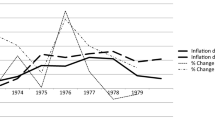Abstract
This essay argues that Milton Friedman’s initial exposition of the inflation tax on money was flawed. Ironically, the flaw traces to Friedman’s attempt to shoehorn the tax into a Keynesian (circa 1936) setting. While the subsequent inflation tax literature has never acknowledged the flaw, it also never utilized a Keynesian setting to exposit the tax.
Similar content being viewed by others
Notes
Friedman (1971) represents a longer, more formal exposition of the inflation tax.
Kleiman also noted that Keynes had several east European contemporaries who were thinking along the same lines.
The textbooks in Van Cott’s sample that included the inflation tax did so outside a Keynesian setting.
To be fair, Van Cott (1981) attempted to put the tax in an IS-LM setting. While the attempt captured the essence of the inflation tax, it slipped and slid through the issues giving rise to Friedman’s fiscal sleight-of-hand. However, the attempt did draw the distinction between the inflation tax and the so-called real balance/Pigou effect. It also pointed to the contrast between an inflation tax explanation of the response to a money-financed increase in government expenditures and what it describes as a rote comparative static IS-LM description.
That Friedman’s consumption and saving functions have zero y-intercepts means that the marginal and average propensities to consume/save are identical. This enabled Friedman to avoid, wittingly or unwittingly, another strand of inflationary gap discussion with 1942 roots—namely, consumer money illusion, Smithies (1942). See Santoni and Van Cott (1976) for an explanation of the irreconcilability of consumer illusion analysis and inflation tax analysis.
The government action is one in which the private sector exchanges goods and services for the government’s new money. To assume that the government claims additional resources at the initial price level is equivalent to assuming the private sector voluntarily moves to a sub-optimal mix of real balances and output. Interestingly, Patinkin’s (1965) treatise in monetary theory had new money injected via additional government expenditures at the initial price level; see Bohanon and Van Cott (1987) for a critique of Patinkin couched in inflation tax analysis.
See Hummel (2007) for a discussion of the revenue possibilities of the inflation tax. Van Cott and Santoni (1977) and Bohanon et al. (1990) point out that the typical method of reporting inflation overstates the tax rate. Incidentally, Hummel does not reference Friedman’s 1953 article, only his 1971 article. In personal correspondence, Hummel confessed to having “…..forgotten all about that older Friedman chapter.....” Except for Kleiman (2000) I suspect that Hummel is not alone in overlooking Friedman’s original inflation tax insights.
References
Abel, A. B., Bernanke, B., & Croushore, D. (2008). Macroeconomics. Boston: Pearson Education.
Bailey, M. J. (1956). The welfare cost of inflationary finance. Journal of Political Economy, 64(2), 93–110.
Bailey, M. J. (1962/1971). National income and the price level. New York: McGraw-Hill.
Barro, R. J. (1973). Inflationary finance and the welfare cost of inflation. Journal of Political Economy, 80(5), 978–1001.
Barro, R. J. (2010). Intermediate macro. Mason: South-Western Cenage Learning.
Bohanon, C. E., & Van Cott, T. N. (1987). Patinkin on a money-financed increase in government expenditures: what happened to seigniorage? A note. Public Finance/Finances Publiques, 42(2), 332–335.
Bohanon, C. E., McClure, J. E., & Van Cott, T. N. (1990). Government inflation statistics and the inflation tax on money. Public Finance/Finances Publiques, 45(1), 162–164.
Friedman, M. (1953). Essays in positive economics. Chicago: University of Chicago Press.
Friedman, M. (1971). Government revenue from inflation. Journal of Political Economy, 79(4), 846–856.
Froyen, R. (2005). Macroeconomics: Theories and policies. Upper Saddle River: Pearson/Prentice Hall.
Gordon, R. J. (2006). Macroeconomics. Boston: Pearson Education.
Hall, R. E., & Papell, D. J. (2005). Macroeconomics. New York: W. W. Norton.
Hummel, J. R. (2007). Death and taxes, including inflation: the public versus economists. Econ Journal Watch, 4(1), 46–59.
Kessel, R. A., & Alchian, A. A. (1960). The meaning and validity of the inflation-induced lag of wages behind prices. American Economic Review, 50(1), 43–66.
Kessel, R. A., & Alchian, A. A. (1962). Effects of inflation. Journal of Political Economy, 70(6), 521–537.
Kleiman, E. (2000). Early inflation tax theory and estimates. History of Political Economy, 32(2), 233–265.
Mankiw, N. G. (2008). Macroeconomics. New York: Worth.
Marty, A. L. (1967). Growth and the welfare cost of inflationary finance. Journal of Political Economy, 75(1), 71–76.
Marty, A. L. (1973). Growth, satiety, and the tax revenue from money creation. Journal of Political Economy, 81(5), 1136–1152.
Patinkin, D. (1965). Money, interest, and prices. New York: Harper and Row.
Phelps, E. S. (1965). Anticipated inflation and economic welfare. Journal of Political Economy, 73(1), 1–17.
Phelps, E. S. (1973). Inflation in the theory of public finance. Swedish Journal of Economics, 75(1), 67–82.
Santoni, G. J., & Van Cott, T. N. (1976). Consumption based private to public redistribution during inflation. Public Finance Quarterly, 4(4), 453–463.
Smithies, A. (1942). The behavior of money national income under inflationary conditions. Quarterly Journal of Economics, 57(1), 113–128.
Van Cott, T. N. (1981). Inflation as a tax on money. Public Finance Quarterly, 9(1), 61–74.
Van Cott, T. N., & Santoni, G. J. (1977). Inflation as a tax on money: correcting an analogy. Atlantic Economic Journal, 5(1), 155.
Williamson, S. D. (2008). Macroeconomics. Boston: Pearson Education.
Author information
Authors and Affiliations
Corresponding author
Rights and permissions
About this article
Cite this article
Van Cott, T.N. Milton Friedman and the Genesis of Inflation Tax Analysis. Int Adv Econ Res 18, 315–319 (2012). https://doi.org/10.1007/s11294-012-9355-2
Published:
Issue Date:
DOI: https://doi.org/10.1007/s11294-012-9355-2




